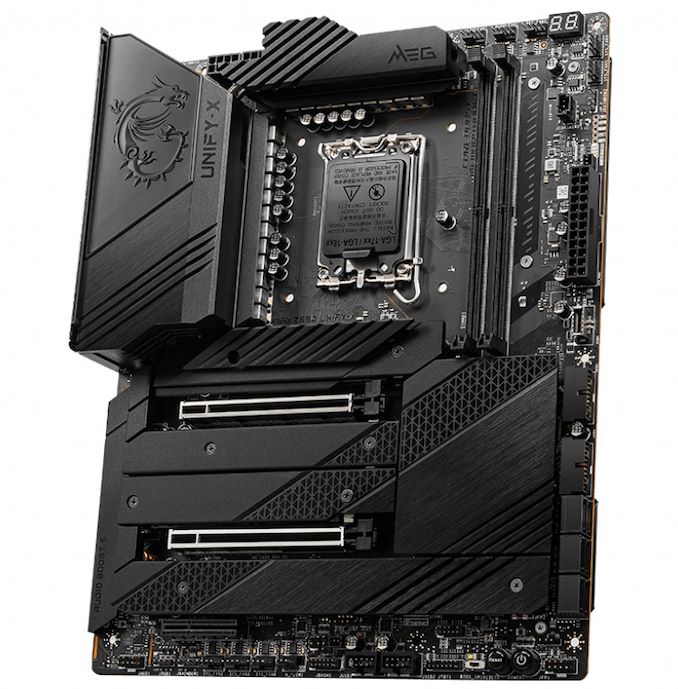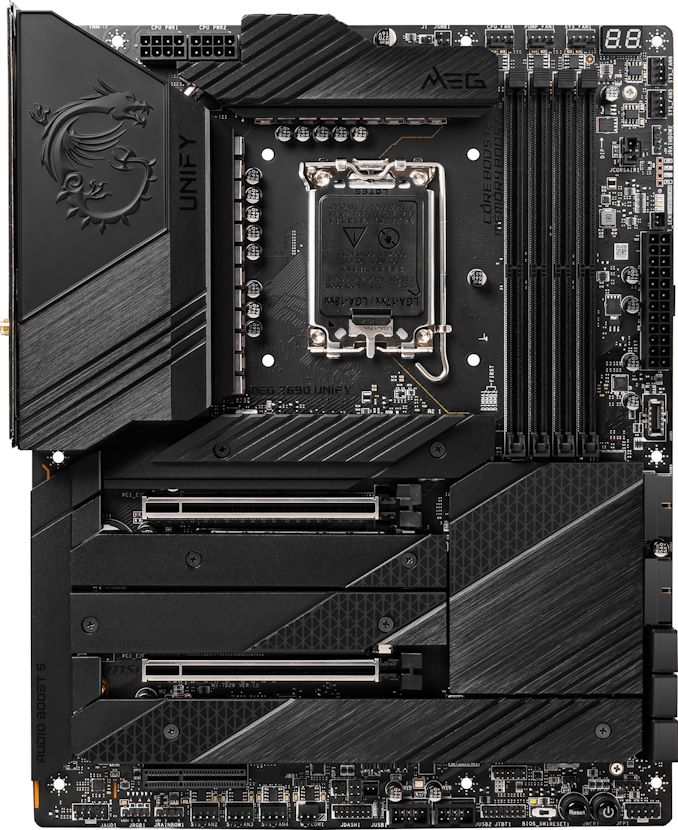The Intel Z690 Motherboard Overview (DDR5): Over 50+ New Models
by Gavin Bonshor on November 9, 2021 9:00 AM ESTMSI MEG Z690 Unify (DDR5) & Z690 Unify X (DDR5)
Sitting below the Godlike and Ace models in MSI's product stack is a pair of Unify branded models. Both the MSI MEG Z690 Unify and Z690 Unify X are a part of the MEG (MSI Enthusiast Gaming) series, with the same core feature set, but with two distinct differences. Aesthetically, both models share the exact same all-black aesthetic we've come to love from the Unify series. This approach was initially marketed as an alternative to RGB clad models, but it has become a solid series for enthusiasts with premium features, good power delivery specifications, and of course, pricing.

The MSI MEG Z690 Unify X with two DDR5-6800 capable memory slots
The MEG Z690 Unify features four memory slots with support for up to 128 GB of DDR5-6666 and is more suitable for gaming, while the MEG Z690 Unify X is aimed at extreme overclockers and enthusiasts with just two memory slots capable of supporting up to 64 GB of DDR5-6800.

The MSI MEG Z690 Unify with four memory slots capable of supporting DDR5-6666
Aside from the obvious differences in memory compatibility and support, both the MEG Z690 Unify and Unify X includes two full-length PCIe 5.0 slots operating at x16 and x8/x8, with a half-length PCIe 3.0 x4 slot. MSI is advertising a large 21-phase power delivery for both models, with both models sharing the same all-black and non-RGB enabled aesthetic, which is sure to please users looking for a more subtle look. Storage options are impressive across both models with four PCIe 4.0 x4 M.2 slots, one PCIe 3.0 x4 M.2 slot, and six SATA ports with support for RAID 0, 1, 5, and 10 arrays.
Both the MSI MEG Z690 Unify and Z690 Unify X are using the same controller set, and as a consequence, the rear panels are exactly the same. On the rear panel of both boards include one USB 3.2 G2x2 Type-C, seven USB 3.2 G2 Type-A, and two USB 2.0 ports. Networking support is strong, with two Intel I225-V 2.5 GbE controllers, and an Intel AX210 Wi-Fi 6E CNVi offering both wireless and BT 5.2 support. MSI hasn't specified the audio controllers, but there are five 3.5 mm audio jacks and a S/PDIF optical output powered by a Realtek ALC4080 HD audio codec. FInishing off the rear panel is a PS/2 combo port, a BIOS flashback button, and a clear CMOS button.











126 Comments
View All Comments
Flying Aardvark - Wednesday, November 10, 2021 - link
"essentially any board with "Thunderbolt 3" along with USB 3.2 2x2 basically get "USB4" status for free."TB3 can run USB 4.0 devices, while USB 3.2 2x2 should be able to, it would be capped at its 20Gbit/sec and run over the backwards compatibility protocol for USB. USB4 ports can be either 20 or 40Gb.
I wouldn't want just USB 4.0 ports as Apple has, capped at 20Gbps. We'll probably see some of that on the AMD side. The best thing is just to have TB3 or TB4 to be sure you have fullspeed 40Gbps ports.
KarlKastor - Wednesday, November 10, 2021 - link
Just optional. If you have Thunderbolt and 10 Gbit USB, you can call it USB 4. See Apple.OFelix - Tuesday, November 9, 2021 - link
I agree. How come there are so few boards with USB4 or TB4 ?And how come the article doesn't mention them at all before it starts listing specific features of individual boards?
DigitalFreak - Tuesday, November 9, 2021 - link
The only way to get USB4 on a PC was by using Intel's Thunderbolt 4 chipset (or having it built into Tiger Lake). Since Thunderbolt is kind of a niche thing on desktop PCs, motherboard makers aren't interested int spending the money on Intel's TB4 chip except in high end or specialty boards. I would assume there will be some third-party USB4 chips coming soon.OFelix - Wednesday, November 10, 2021 - link
Thanks for your reply.So USB4 was built in to Tiger Lake but its not built in to Alder Lake / Z690????
That would explain somethings but not explain why on earth Intel would do that or AnandTech would not think this major regression worth mentioning!!!
The main reason I want to upgrade from my Sky Lake system (which i purchased to get built in USB3) is to get USB4/TB4.
KarlKastor - Wednesday, November 10, 2021 - link
TB is only integrated in the mobile Dies. The Desktop Die has no TB.Alistair - Tuesday, November 9, 2021 - link
DDR5 is not faster in almost every case, and there are no PCIe 5 devices (unlike when PCIe4 was launched at least you got video cards and storage immediately). Not really an advantage. Prices are too high also. Frankly I like PCIe 3.0 boards when they are under $100 USD.DigitalFreak - Tuesday, November 9, 2021 - link
It's the same thing that happened during the DDR3 to DDR4 transition. The first DDR4 products weren't really any faster than the best DDR3. Eventually DDR4 speeds got faster and left DDR3 behind. Same thing will happen with DDR4 to DDR5.Kevin G - Tuesday, November 9, 2021 - link
PCIe 4.0 support was significantly delayed on the desktop but it arrived in servers in 2017 (IBM Power9). AMD was planning on adopting PCIe 4.0 after Intel on the desktop but Intel's train wreck of their 10 nm manufacturing node derailed the chips what were going to add it (Ice Lake on desktop).I would expect both PCIe 5.0 graphics and storage by the end of 2022 on the desktop, though their benefits will be marginal outside of a few niches. (Single lane PCIe 5.0 chips for USB4/Thunderbolt 4 and 10 Gbit Ethernet vs. using four PCI 3.0 lanes are cost driven examples.)
Samus - Wednesday, November 10, 2021 - link
Kevin G - I agree, I think in a year there will be PCIe 5.0 devices, but the performance advantages, much like initial PCIe 4.0 devices (RTX 30xx, NVMe SSD's, etc) won't be there until 2023-2024, by which time this platform will already be replaced or significantly less expensive.I don't think Intel is looking to drive a lot of sales with this platform. Not many people are buying $3000 desktop PC's at the moment (and when you consider the platform alone is $500, with a $500 CPU on top of it, $3000 is pretty conservative considering most people buying something like this will want a $1000+ GPU, so that's $2000 for three components.)
Put in perspective, the last launch like this that had a lot of tech that you couldn't take advantage of right away was probably X58. PCIe 2.0 at a time no PCIe 2.0 products existed, and 36 lanes no less, left a ton of room to expand a platform that was already stacked to the gills with embedded tech. In fact it would be years before applications were fully optimized for the bandwidth offered by triple channel memory, let alone quad channel memory that Intel introduced on later HEDT platforms.
The difference though is X690 isn't even HEDT.